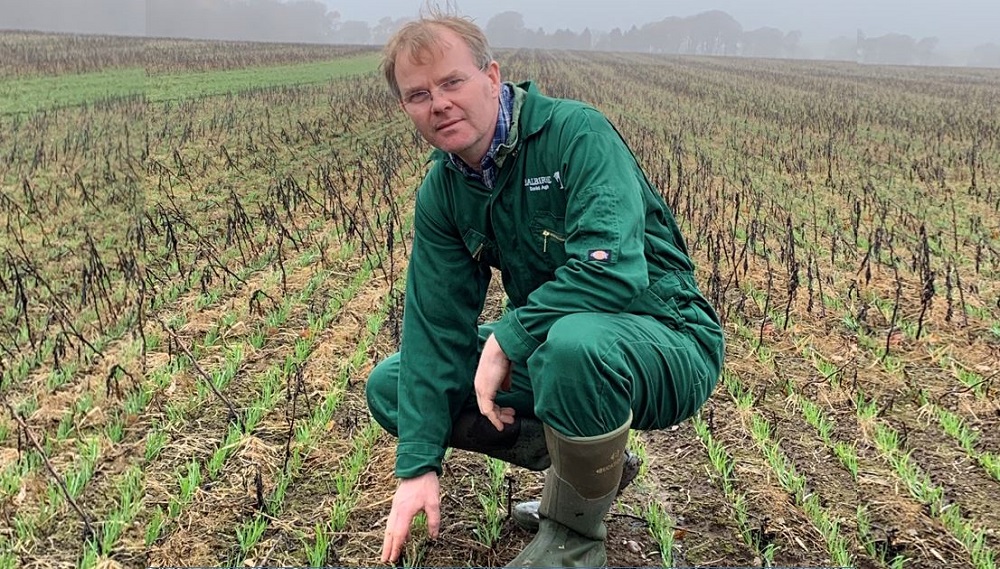- Home
- Knowledge library
- Assessing soil health at Balbirnie Home Farms
Assessing soil health at Balbirnie Home Farms
Earthworm assessments and measuring soil respiration have helped improve soil management at Balbirnie Home Farms.
Back to: How to count earthworms
Introduction to Balbirnie Home Farms
David Aglen is Farms Manager at Balbirnie Home Farms, a 1,200 ha mixed farming enterprise in rural Fife, 35 miles north of Edinburgh. The soil is a moderately varying sandy loam with a sandy subsoil. This allows a varied rotation which includes carrots, potatoes, cabbages and cauliflower, as well as combinable crops, grass and forage crops for the cattle enterprise.
David said: “Nurturing the fragile structure of these soils while growing mechanically intensive crops is becoming a major driver of the rotation. An absolute minimum level of cultivation is used for the establishment of the combinable crops, along with vegetable and root crops only being grown one year in four across the 900 ha of cropped land.”
Cover crops
One of David's recent innovations has been to grow an overwinter cover crop of stubble turnips or vetch after harvesting winter barley in August and before sowing spring oats in April. In many cases, the cover crops are grazed off by the farm’s livestock prior to ground preparation for the next crop. The aim of such innovations is to reduce soil erosion, save money, reduce the carbon footprint and increase biodiversity.
“This has been a steep learning curve to date. We seem to have a fairly limited choice of cover crop species, so far, that will establish successfully in late August and September in central Scotland,” David said.
David has been interested in testing the soil at Balbirnie Home Farms to measure the effect of organic amendments, such as compost and straw, on soil health.
One of the aims was to include assessments of soil biology, but he was unsure how to go about it. David consulted with soil health expert Dr Audrey Litterick of Earthcare Technical Ltd., and both agreed to monitor earthworm counts and to test for life by measuring soil respiration.
Earthworm count at Balbirnie
East Moss Field and East Field were sown with carrots in the first week of May 2016. Earthworm counts were done in both April and September, at four locations within each field and at two locations in the field margins. There were good numbers of earthworms in the uncultivated field margins in April, but fewer (and a higher proportion of juveniles) in the cultivated areas of the fields.
Earthworms are very sensitive to soil disturbance, and the species Lumbricus terrestris can burrow down to 2.5 m and therefore go out of range of the soil sampled.
In East Moss in April, the worm counts in the four samples varied from one to 14 (Table 1). There were fewer worms counted in the top 30 cm of soil in September compared to April, probably due to the dry soil conditions at the time of sampling (no worms were found in the cultivated field areas).
Table 1: Balbirnie Estates – seasonal differences in earthworm counts in cultivated versus uncultivated fields
| Earthworm counts | East Field (8 ha) | East Moss (6 ha) | ||
|---|---|---|---|---|
| April | September | April | September | |
|
Cultivated area |
6 |
0 |
7 |
0 |
|
Uncultivated field margins |
14 |
2 |
27 |
3 |
Soil respiration testing at Balbirnie
In April 2017, after the carrot crop had been harvested, East Moss field was divided roughly into four. Each quarter of the field had a different treatment, the eastern half had straw applied at approximately 50 t/ha and the northern half had compost applied at 20 t/ha. Paper crumble was also applied to the entire field at 20 t/ha. The organic materials were cultivated in and the field was sown with spring barley in May.
Twenty samples of soil were taken from each of the four treatment areas in May 2017, bulked and subsampled for analysis. Respiration of the fresh soil was measured using the Solvita® field test method.
A sample of approximately 90 g soil was placed in a sealed jar with a CO2 indicator. After 24 hours, the amount of CO2 produced was measured using a digital colour reader. During transport from the field to the test room, the soils were stored in a polystyrene cool box containing cool packs. The tests were set up the same day on which samples were taken.
The addition of straw to this field (soil organic matter content 4.1%) caused an obvious increase in soil respiration compared to soil which did not receive straw, indicating an improvement in the soil health.
Compost had no effect after a single application, but can have beneficial effects on soil respiration when applied over several years. Soil respiration readings were shown to be a good indicator for measuring the impact of reduced cultivation on soil health.
Note: Soil respiration testing done at Balbirnie in 2017 was superseded by research carried out by the Soil Biology and Soil Health Partnership in 2020.
Further information
 AHDB
AHDB

